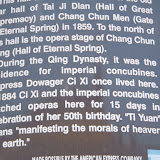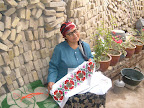 After going into a bit of a political rant last time, I thought I should bring things back to textiles (without promising not to stray into other areas). Well, it's a knitting blog, after all, and time to update you on my current design inspirations and projects. I think this is going to end up being quite a long entry!
After going into a bit of a political rant last time, I thought I should bring things back to textiles (without promising not to stray into other areas). Well, it's a knitting blog, after all, and time to update you on my current design inspirations and projects. I think this is going to end up being quite a long entry! Of course, my main inspirations in the last few weeks have come from my fabulous trip to China and Kyrgyzstan. On the downside, there were quite a few relentless travelling days which meant that time for textile browsing sometimes got squeezed. On the upside, though, were several museum visits and a trip to a silk factory, which provided lots of insights into the traditions and production of Central Asian textiles, which are a big inspiration for me. You can see a slideshow of some of the photos from the trip by clicking on the picture below:
 |
| 50th birthday trip |
We stopped first at the Xinjiang Regional Museum in Urumchi, which set the context for the regions and the peoples of Western China, although this was presented in a rather faux-naif Soviet-style of "here are all our wonderful ethnic groups, aren't they cute"? In a twist of history Russians were included in this section, not sure how the fallen-but-trying-to-rise-again Empire would feel about that! Urumchi (Chinese Urumqi) is also famous for its mummies and you can read more about these here: www.mummytombs.com/mummylocator/group/urumchi.htm
The Loulan mummy is certainly very impressive and has an exquisitely delicate bone structure. There is something intensely beautiful about skeletal structures. At the museum I kept thinking of a programme we'd been watching just before going away about how humans all share the same DNA source from a small African diaspora, disproving certain Chinese theories that the Han people have a separate origin. I tried to make some sketches in the museum (no photos allowed) but it was difficult with the distractions of school parties and somewhat officious guards anxious that we went the right way round!
The hotel we stayed at in Urumqi was also a strange place: men and women alike received a phone call from the basement offering sexual services! Trying to fall asleep after that I felt really aware of being in the wild East, perhaps also influenced by reading Peter Hopkirk's book about the Great Game. And, however acceptable liberal protagonists would like to make the sex industry, I can't see any positives in young women resorting to earning a living in this way. The contrast between this and the covering up of women required in the Uighur Muslim community was both interesting and confusing. Neither approach fits with my view of what gender equality is all about, and may indeed be different sides of the same coin.
After crossing the Takla Makan desert (see last entry) we stayed a couple of nights in Hotan which, before being conquered by first Islam and now the Chinese, was previously the ancient Buddhist kingdom of Khotan, see en.wikipedia.org/wiki/Kingdom_of_Khotan. There was evidence of much destruction of Buddhist culture under Islam and of course now the Chinese are making considerable changes themselves; however this is still a major silk production area. Our trip to the Atlas Silk factory was really interesting, although I'm not so keen on boiling worms! I did buy a very nice piece of silk in natural dyes while we were there.
 |
| From Central Asian Textiles |
While in Hotan we also visited the local museum, where there were some really interesting examples of textile work (again no photos allowed), and the old town, where several women invited us into their homes and one showed us her beautiful cross-stitch embroidery.
 |
| From 50th birthday trip |
Continuing our journey towards Kashgar, we stopped off at a local market in Kargalik (one of our best stops) where I bought some very simple woven braids.
 |
| From Central Asian Textiles |
In Kashgar we visited the livestock market which was utterly absorbing (and much better than the traditional Sunday market, which has been moved indoors.) There were lots of the famous fat-tailed sheep for sale and evidence of felting and weaving techniques in the blankets and decoration on traditional wooden carts and donkeys. I also noticed this cross-stitch hat being worn by one of the young girls and became fascinated by the apparently machine-knitted brown veils that some of the older women wore.
 |
| From 50th birthday trip |
 |
| From 50th birthday trip |
The veils had a definite and consistent pattern, mixing garter stitch with basket weave, although it was hard to get too close without being considered rude! Although made of quite lightweight yarn they must be very difficult to see through unless you really know your way! Back in the centre of Kashgar near the mosque, I watched one woman sifting through brightly covered synthetic scarves set out for sale on the pavement. She used one hand for sifting and the other to lift her veil to see, but very expertly so that her face remained invisible. Yet I saw other women wearing this type of veil folded back over their heads revealing the face, so there must be subtleties of practice and expectation of which I was completely unaware. I would have liked to buy one of these brown veils and but didn't see any sign of them for sale in the local markets.
From Kashgar we did one day trip along the Chinese bit of the Karakoram Highway (another highlight). At the checkpoint on the way back I saw a woman using a drop spindle, the only time during the trip. Unfortunately as we were at a sensitive area I was advised by our guide that asking to take her photo was not a good idea.
After Kashgar we crossed into Kyrgyzstan. This was an experience in itself - nearly four hours to complete the crossing, through at least four checkpoints. For one bit two Chinese soldiers decided to come onto the bus with us. They promptly fell asleep, and I think just wanted a ride in our air con, but not before they had told our tour guide to put his shoes back on...
Kyrgyzstan, probably the poorest of the five former Soviet Central Asian republics, is a stunningly beautiful country, although still prone to some soviet-style attitudes to tourism. We were wonderfully welcomed and looked after everywhere we stayed (two nights in yurts, two nights in a lovely guest house in the capital Bishkek) but we had three long travelling days during which rest breaks and photo stops were only grudgingly given. We were also rushed through a textile stop (some interesting felting techniques but items for sale mostly adapted for a Western tourist market)in order to visit a very polluted and un-scenic lakeside in a run-down town at Lake Issyk-Kul. I was not impressed, although I gather that there are more delightful spots we could have visited.
However, much the best bit of our stay in Kyrgyzstan, was a day at leisure in Bishkek (our last day before heading home) where we wandered round in a very chilled state, had leisurely meals and took a ride on a ferris wheel in one of the many leafy parks. At the local history museum, as well as beautiful textile displays and a weird but extensive Lenin collection, we met the lovely Nina and Rita, who run a souvenir shop which provides an outlet for local women to sell handmade textiles, mostly embroidery with some woven pieces. These are mainly older pieces that have been created within the seller's family and are adapted for modern use. I shopped.
See a slideshow of the pieces that I bought here:
 |
| Central Asian Textiles |
Meanwhile, back in the UK I am slowly returning to my knitting projects. I've completed a top in Rowan Bamboo tape that was taken from Rowan magazine 43 (Mine, p. 117) to which I introduced my own striped design for the front. It worked really well (better than I deserved since I didn't work it all out in advance, tut tut) and I was greatly helped by advice from members of my knitting group - Jam Factory Knitters in Oxford - about how and where to place the colours, both for body shape and visual appeal.

As always I learned a lot from doing this design work and I am greatly enjoying wearing the result. I wore it to a City and Guild students' gathering at Winchester School of Arts this week, where we viewed the displays of recent graduates in fashion and textiles, and talked about our own progress.
So now it's back to Module 3, armed with lots of fresh ideas from my travels. These are very timely, not just the silk project, but also the exercises on print, line-marking and applying embroidery to knitting. And I also have a course on plaiting baskets to look forward to at the Oxford Summer School in July. More next time.
Finally - and if you've read this far, congratulations - don't forget that there is still time to donate to my birthday charity via my website below. An amazing £1075 has been raised so far for the Lavender Trust at Breast Cancer Care.
www.justgiving.com/susannareece
And check out Other Half's blog too: http://rossmac.blogspot.com/



